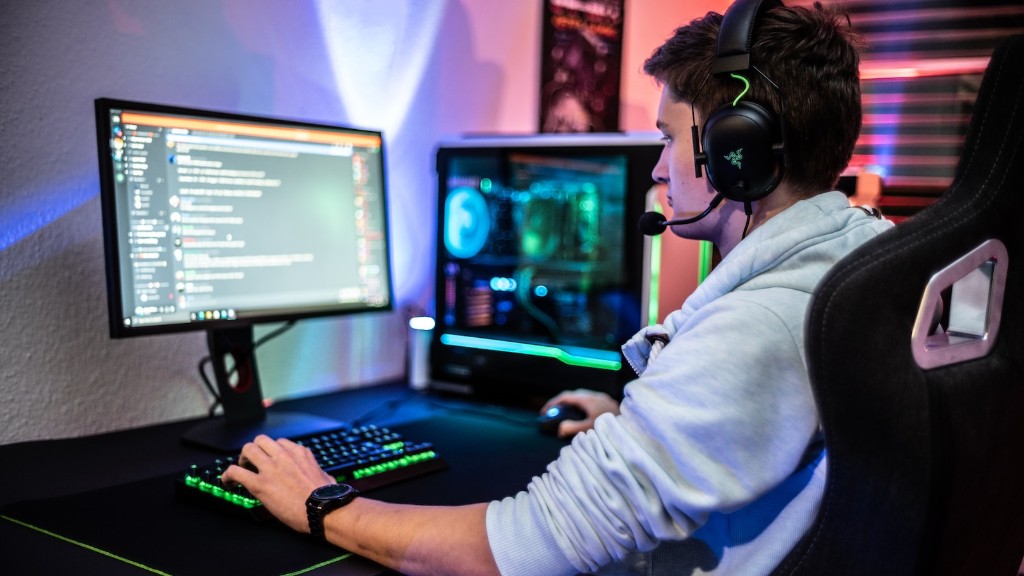It’s easy to get overwhelmed when deciding what kind of gaming monitor to buy. Size is a critical aspect, as it affects how comfortable and immersive the gaming experience is for the player. So, what size gaming monitor should you choose?
The ideal size for a gaming monitor depends on a few factors. Firstly, the size of the room where you’ll be gaming. Secondly, your budget and the kind of graphics quality you’re looking for. Thirdly, the type of games you’ll be playing, as well as resolution and frame rate requirements.
Most gamers opt for a monitor that’s between 19 and 27 inches. A larger monitor will definitely have an impact on your gaming experience and immersion, but it’s important to remember that bigger mean better. In some cases, it may be better to go with a smaller screen, as bigger screens often require higher resolution and/or better graphical performance.
One of the main reasons to pick a larger monitor is if you’re into multi-monitor gaming. Multi-monitor gaming involves two or more screens linked together, providing a wider view and an immersive gaming experience.
For most gamers, the type of application they’ll be using should be a consideration. If you’re into PC gaming, then you’ll want to opt for a curved ultrawide monitor to get the best gaming experience. For console gaming, a larger monitor could be better as it can provide a greater degree of immersion.
Finally, aim for a monitor with a fast refresh rate, as this will result in smoother gameplay. Many gamers opt for at least 75 or even 144Hz for faster frames.
In the end, it’s important to factor in all these considerations before selecting your gaming monitor, as this will ensure you make the best decision.
What Are Some Tips for Choosing the Right Monitor Size?
When deciding which gaming monitor to buy, it’s important to take into account all of the factors mentioned above. Not only should you consider the size of the room you’ll be gaming in, but also the type of graphics you need, the kind of games you’ll be playing, the resolution and frame rate requirements and whether or not you’ll be using multiple monitors.
One general rule you can use when selecting the best gaming monitor size is to ensure it’s at least as big as your desktop. This will give you an indication of the size you need and make sure it fits on your gaming desk. If you’re after an immersive experience and look for a monitor larger than 24 inches, consider curved screens for a more unrestricted field of view.
It’s also important to balance physical size with resolution, as the resolution of a gaming monitor directly affects the picture quality. You should ideally aim for a gaming monitor with a resolution of 1080p or higher. This will provide detailed visuals and smooth gameplay.
Another factor to consider is refresh rate. Refresh rate is the number of times a gaming monitor updates the display in one second. It’s measured in Hertz (Hz). The higher the refresh rate, the smoother the gaming experience. Aim for a gaming monitor with a refresh rate of at least 75 Hz or higher.
In the end, the best gaming monitor size is up to each individual gamer. Choose a size that fits your needs, provides the best visuals, and ensures an immersive and enjoyable gaming experience.
Should I Get a 4K or an Ultrawide Monitor?
4K and ultrawide monitors have become popular choices for gamers over the last few years. Both provide a great gaming experience, but each type has its own unique benefits.
If you’re into PC gaming and have a powerful graphics card, then an ultrawide monitor is the best choice. Ultrawide displays come in either 21:9 or 32:9 aspect ratios and provide an expansive view of the game. They also offer a more immersive experience, as the wider field of view makes the gaming environment feel more like reality.
4K (or UHD) gaming monitors provide an even higher level of detail to the game. These monitors have a screen resolution of 3,840 x 2,160 pixels and provide four times the level of detail of a 1080p monitor. This higher resolution makes the graphics look sharper, and they often come with an IPS panel that profits from wide viewing angles.
If you’re looking for a gaming monitor that provides a great gaming experience, then it’s worth looking into both options. Ultrawide displays provide an expansive and immersive gaming experience, whereas 4K monitors offer more detailed visuals and wide viewing angles.
What Are the Best Gaming Monitors?
There are plenty of gaming monitors on the market, and many of them come with additional features such as G-Sync, Ultra Low Motion Blur and VESA Certified Adaptive Sync. To make sure you get the best gaming experience, it’s important to select the right monitor.
When deciding, it’s always worth paying attention to what kind of ports the gaming monitor supports. This will determine which type of graphics card you can use. Ensure the monitor you’re looking at has DisplayPort, HDMI or DVI ports, depending on what your graphics card supports.
High-end gaming monitors are often advertised as having features like G-Sync and VESA Certified Adaptive Sync. These features can improve the foot-rate stability and eliminate visual artifacts caused by graphics card or processor instability. However, not all games benefit from these features.
In the end, it’s important to have realistic expectations when selecting a gaming monitor. While higher-end models may come with extra features, the key to a great gaming experience is ensuring you have the right size, resolution, and refresh rate.
What Are the Benefits of a Larger Gaming Monitor?
Larger gaming monitors offer many advantages over smaller displays. They provide a more immersive gaming experience, as well as a wider field of view, which can give you an edge over other players.
In addition, larger monitors can improve the performance of your games, as they enable more details to be displayed on screen. This can benefit your gaming skills, as more detailed visuals of the game can help you make better split-second decisions.
Bigger gaming monitors also reduce eye strain and headaches. The bigger the monitor, the less the user needs to tilt the head and the less time their eyes spend focusing on small details. This can help make longer gaming sessions more comfortable.
Finally, larger gaming monitors also provide more space to customize your gaming setup – you can fit more than one monitor, extra keyboards or controllers, or a few extra speakers.
Do Bigger Gaming Monitors Have More Input Lag?
Input lag is the time it takes for a gaming monitor to display an image after the screen has been refreshed. It can be caused by a number of factors, such as slow graphic drivers, poor connections, or the monitor’s own backlight.
A larger gaming monitor generally performs worse than smaller ones in terms of input lag, as there is more distance between pixels. That said, modern gaming monitors feature overclocking, which can drastically reduce input lag on large monitors.
To ensure you get the lowest possible input lag, pick a gaming monitor with an IPS panel. IPS panels typically offer the lowest input lag, faster response time, and better viewing angles compared to other panel types.
For the best gaming experience, it’s important to make sure you pick a gaming monitor with the lowest possible input lag. IPS panels are the best choice in this regard, but other features such as refresh rate, resolution, and size should also be taken into consideration.


